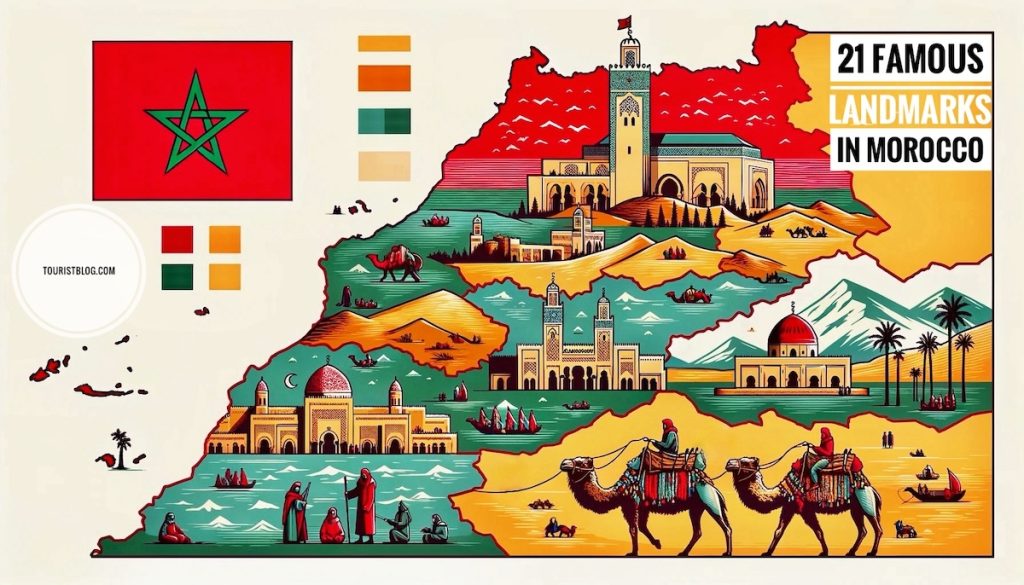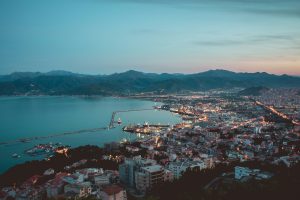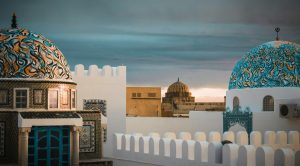In this exploration of the most famous landmarks in Morocco, you’ll discover not only the country’s architectural marvels but also the rich tapestry of history and culture that makes Morocco such an enchanting destination for tourists and why it’s one of the most visited countries in Africa.
From the towering minarets and grand palaces to the serene mountains and the hardworking camels of the vast deserts, these landmarks are windows into Morocco’s soul, offering insights into a land where ancient traditions blend seamlessly with modern vibrancy.
It’s a very intense country and it’s not for the faint of heart, as tourists often can not handle the hustle and bustle of the markets.
With that in mind, we will look at the famous landmarks in Morocco that are manmade and natural; offering you the chance to experience both and escape into nature whenever you’re done with the commotion of the well-trodden tourist path of Marakesh.
Famous Manmade Landmarks in Morocco
Most of Morocco’s famous manmade landmarks standing today were created during various periods, reflecting the country’s rich historical tapestry.
These include influences from ancient Berber kingdoms, Islamic dynasties, and periods of Roman and European rule.
The mosques and the palaces of former royals showcase a blend of architectural styles from different eras, embodying Morocco’s diverse cultural heritage. The nation’s historic monuments and sites are protected and conserved under Moroccan law, highlighting their significance as part of the country’s national heritage.
Hassan II Mosque
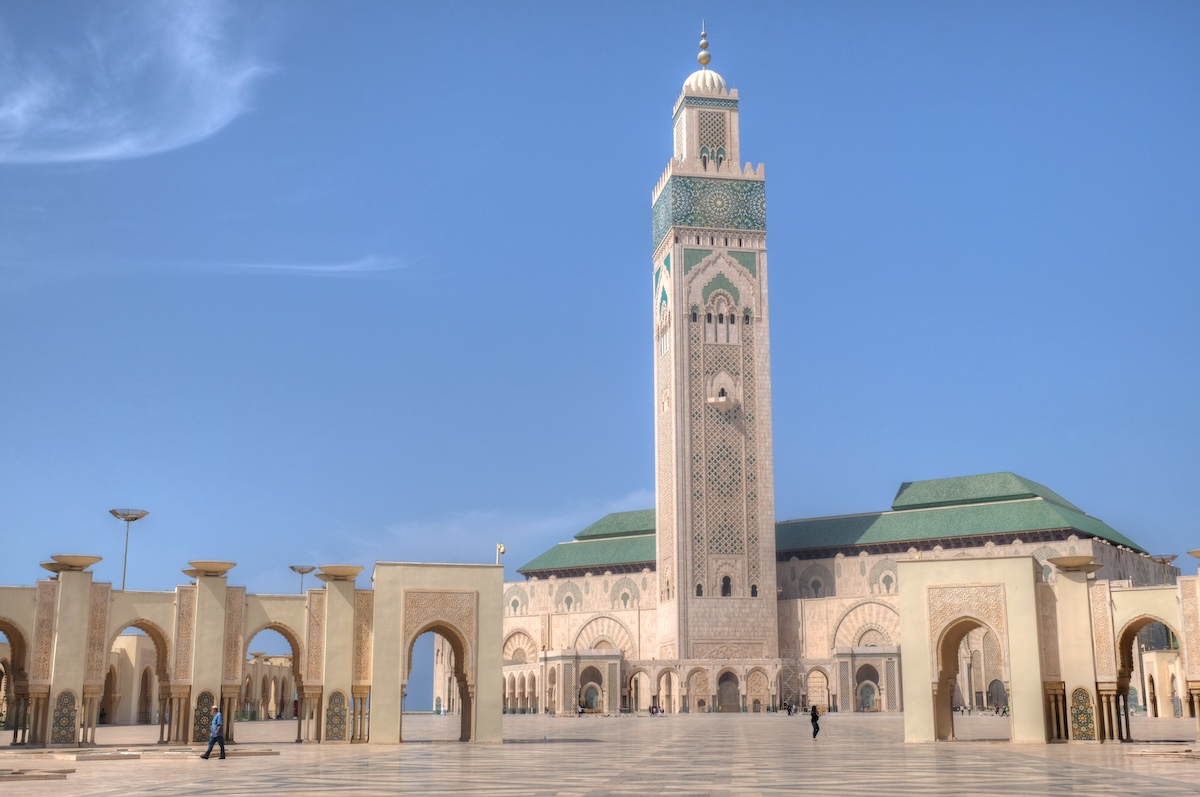
The Hassan II Mosque, located in Casablanca, is not just an architectural marvel but also a symbol of Morocco’s religious heritage and non-Muslims are allowed an inside visit to this beautiful mosque.
Standing partly over the Atlantic Ocean, its minaret was the tallest in the world before being kicked out of The Guinness Book of Records by one of Algeria’s most iconic landmarks.
The mosque’s history is tied to its grandeur; it was commissioned by King Hassan II and designed by French architect Michel Pinseau. Its construction involved thousands of artisans, showcasing intricate Moroccan craftsmanship.
Visitors are drawn to its astounding size, accommodating up to 105,000 worshippers. The mosque blends Islamic architecture with Moroccan elements, featuring a retractable roof and stunning sea views. It’s a place where spirituality meets the ocean’s horizon, making it unique.
Know Before You Go:
Best Time to Visit: Spring (March to May) or Autumn (September to November) for mild weather; visit in the morning for fewer crowds.
Getting There: Accessible by taxi or tram from central Casablanca.
Duration: Tours last around 45 minutes to an hour.
Tickets: Entrance fee varies; guided tours available in several languages.
Facilities: On-site facilities include restrooms and a small café.
Accessibility: The mosque is wheelchair accessible, with ramps and elevators available.
Koutoubia Mosque
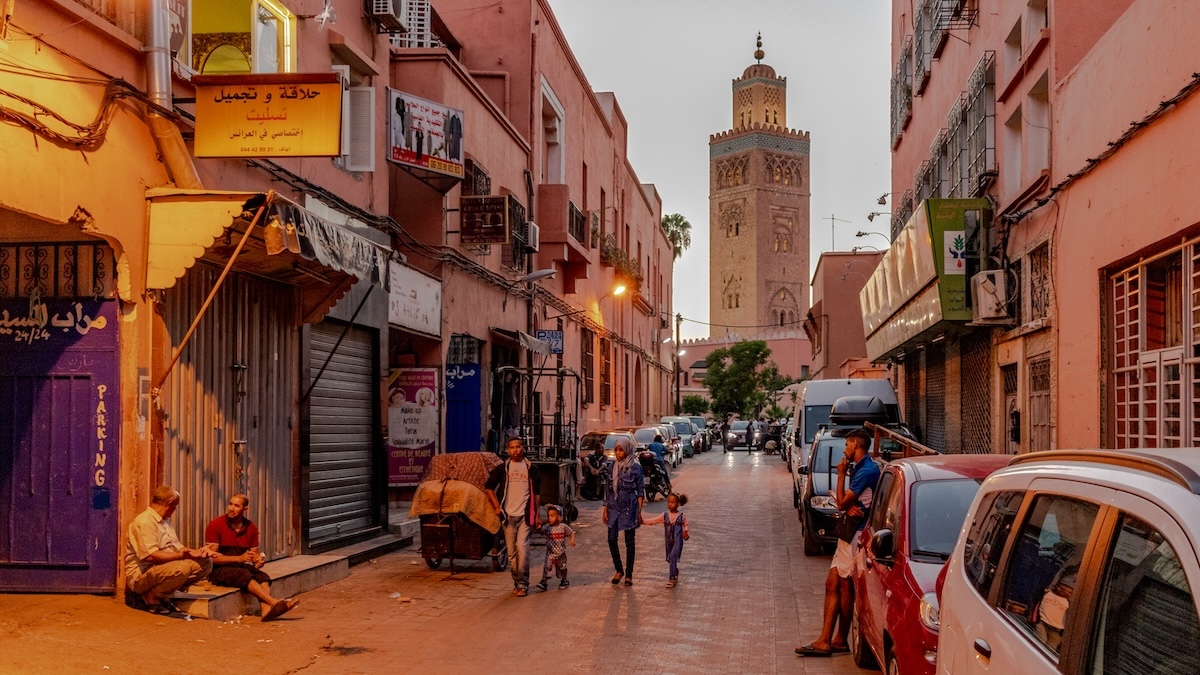
Koutoubia Mosque, the largest mosque in Marrakech, is famous for its striking minaret, visible for miles and a classic example of Almohad architecture. The mosque’s history dates back to the 12th century, mirroring the city’s historical and spiritual journey. Its name, ‘Koutoubia’, is derived from the Arabic word for ‘bookseller’, reflecting the mosque’s past surrounded by book markets.
Visitors are attracted to its serene gardens and the imposing sight of the minaret against Marrakech’s skyline. Although non-Muslims cannot enter the mosque, the surrounding gardens offer a peaceful retreat with great views of the mosque.
Know Before You Go:
Best Time to Visit: Early morning or late afternoon for the best light for photography and cooler temperatures. A gentle reminder that non-Muslims can only visit outside of the building.
Getting There: Located in central Marrakech, easily accessible on foot from Jemaa el-Fna or by taxi.
Duration: Visitors typically spend 30 minutes to an hour in the surrounding gardens.
Tickets: No entrance fee for the gardens; mosque entry is restricted to Muslims.
Facilities: Local cafes and restaurants are nearby.
Accessibility: The gardens and areas around the mosque are accessible to those with mobility issues.
Bahia Palace
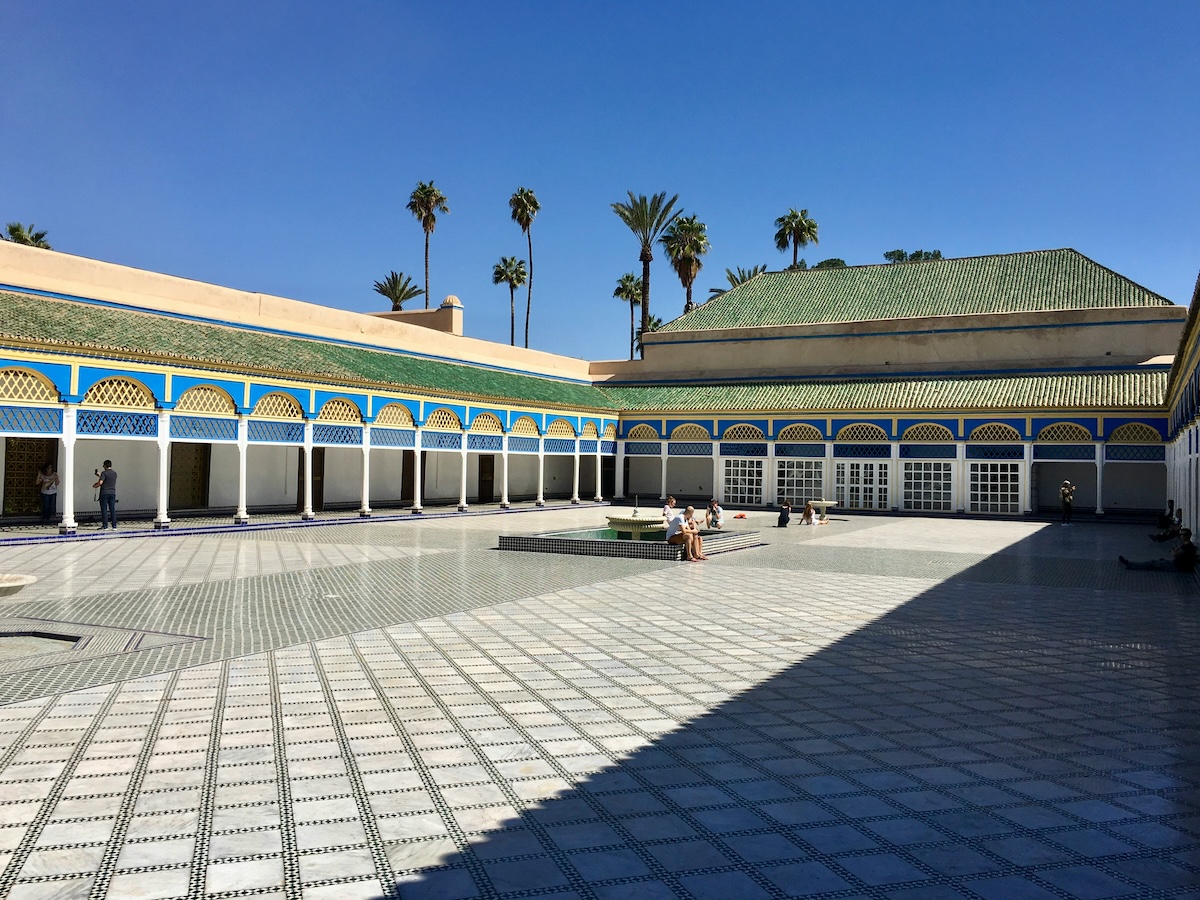
Bahia Palace stands as a testament to the brilliance and opulence of Moroccan architecture. Built in the late 19th century, it was intended to be the most magnificent palace of its time, reflecting the beauty of Islamic and Moroccan design. The name ‘Bahia’ translates to ‘brilliance’, appropriate for its splendid gardens, intricately tiled courtyards, and ornately carved ceilings.
The palace is not just an architectural marvel but also a cultural treasure, offering insights into the lavish lifestyle of Moroccan royalty. Each room in the palace, from the grand reception halls to the private quarters, displays meticulous craftsmanship and artistry, making it a must-visit for those who appreciate historical and architectural richness.
Visiting Bahia Palace is like stepping back in time, where the elegance of the past meets the present. It’s a place where the history of Morocco’s nobility is etched in every tile and carved wood panel, offering a unique and enchanting experience for visitors.
Know Before You Go:
Best Time to Visit: Early morning to avoid crowds.
Getting There: Accessible on foot from Jemaa el-Fna square or by taxi.
Duration: 1 to 2 hours.
Tickets: Approximately 70 Moroccan Dirhams ($7 USD).
Facilities: Cafes and shops nearby; limited facilities inside.
Accessibility: Partially accessible, but some areas may be challenging for those with mobility impairments due to uneven surfaces and steps.
Ait Benhaddou
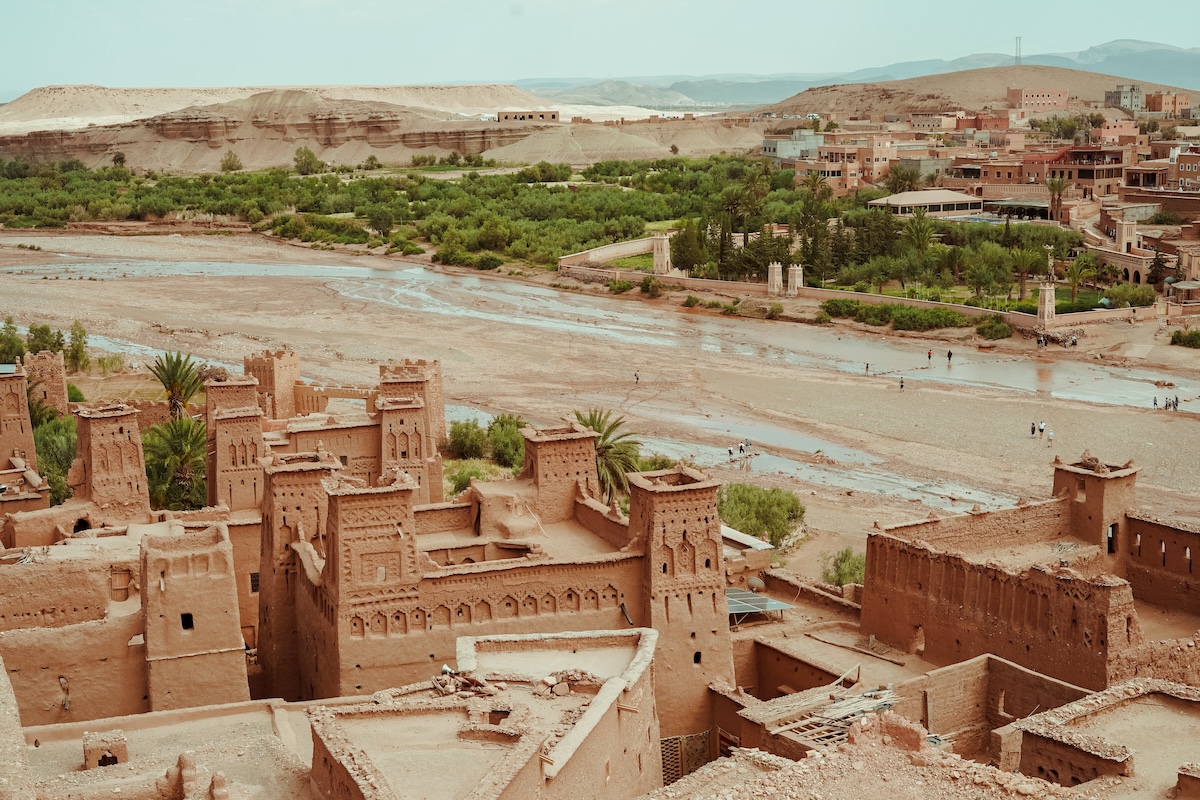
Ait Benhaddou, a striking example of southern Moroccan architecture, stands as a UNESCO World Heritage Site. This ancient ksar, or fortified village, has been a silent witness to centuries of history, once serving as a crucial stop along the caravan routes between the Sahara and Marrakech.
Its unique earthen clay architecture, characterized by tall defensive walls and corner towers, showcases the ingenuity of traditional Saharan building techniques.
The village’s preservation allows visitors to experience a bygone era, where the maze-like warren of houses and granaries narrates stories of the past. Ait Benhaddou’s allure has also captured the attention of Hollywood, serving as a backdrop for numerous films and thus gaining international fame.
A visit to Ait Benhaddou is not just a journey through Morocco’s architectural heritage but also a step into the pages of history. The panoramic views of the ksar against the backdrop of the Atlas Mountains are breathtaking, offering a moment of awe for every visitor.
The city also hosts the annual Marathon des Sables, dubbed “The Toughest Footrace on Earth,” a gruelling 6 marathons in 6 days in the Moroccan Sahara Desert!
Know Before You Go:
Best Time to Visit: Early morning or late afternoon to avoid the heat.
Getting There: Accessible by car or guided tours from Ouarzazate or Marrakech.
Duration: 2 to 3 hours.
Tickets: No entrance fee; fees for local guides vary.
Facilities: Souvenir shops and cafes nearby.
Accessibility: The terrain is challenging for those with mobility issues due to steep and uneven paths.
Royal Palace
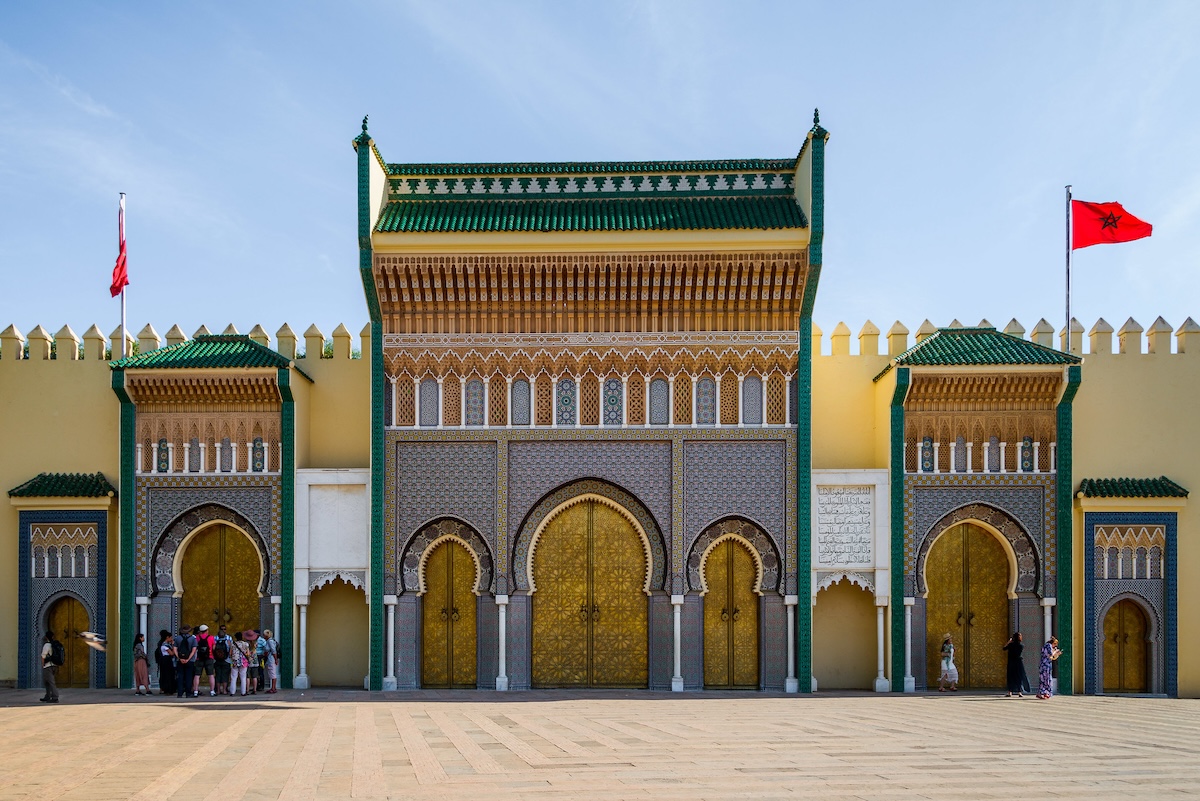
The Royal Palace of Fez, also known as Dar el Makhzen, is the epitome of the Moroccan monarchy’s grandeur and artistry.
While the interiors remain exclusive to royalty, the palace’s exterior, especially its ornate golden gates, is a spectacle that captivates onlookers. These gates are adorned with intricate brass work and colorful tile mosaics, showcasing the skill and creativity of Moroccan craftsmen.
The palace, nestled in the heart of Fez, provides a stark contrast to the bustling life of the old Medina, highlighting the blend of Morocco’s regal history with its vibrant culture.
The Royal Palace’s sprawling complex, with its numerous buildings, gardens, and mosques, is a testament to the architectural prowess and historical depth of Morocco. The palace is not just a symbol of the country’s monarchical past but also a reminder of the cultural fusion that characterizes Moroccan history.
The intricate design and layout of the palace reflect a rich blend of Arab and Berber influences, making it a significant landmark in Moroccan heritage.
For visitors, the Royal Palace gates offer a glimpse into the royal aesthetics of Morocco. The area around the palace is equally fascinating, teeming with traditional Moroccan life and providing a unique cultural experience. Walking around the palace perimeter offers an insight into the opulence of Moroccan royal architecture and the everyday life that unfolds in its shadow.
Know Before You Go:
Best Time to Visit: Daytime for the best lighting for photography.
Getting There: Easily accessible by taxi or on foot from Fez’s Medina.
Duration: 30 minutes to 1 hour for exterior viewing.
Tickets: Not applicable as the interior is closed to the public.
Facilities: Shops and cafes in the surrounding area.
Accessibility: The exterior is accessible, but there’s limited access to facilities for those with disabilities.
Volubilis
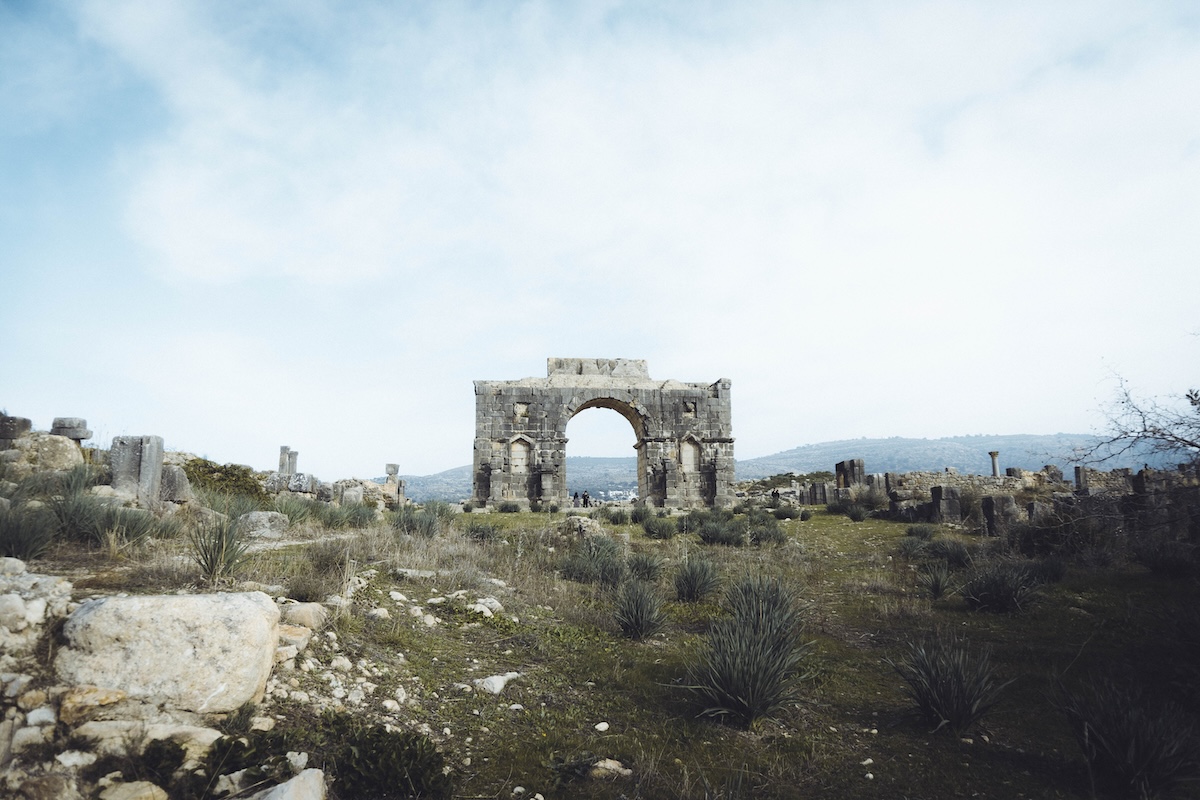
Volubilis, situated near Meknes, is a powerful symbol of the Roman influence in Morocco. As a UNESCO World Heritage site, it stands as one of the best-preserved Roman ruins in North Africa.
The city was a crucial administrative center for the Roman Empire and played a significant role in the spread of Roman culture and politics in the region. The ancient ruins, including the Forum, Basilica, and Triumphal Arch, provide a vivid window into Roman urban design and lifestyle.
The site’s most striking features are its stunning mosaics, preserved in several of the city’s houses. These mosaics depict various aspects of Roman life and mythology, offering insights into the artistic and cultural endeavors of the time.
Volubilis is an archaeological site with a scenic location that blends history with natural beauty. The surrounding rolling hills and lush landscapes provide a serene backdrop to the ancient stone structures.
This harmony of nature and history makes Volubilis a unique destination, appealing not only to history enthusiasts but also to those seeking a picturesque and tranquil setting.
Know Before You Go:
Best Time to Visit: Early morning or late afternoon to avoid the midday heat.
Getting There: Drive or take a guided tour from Meknes or Fes.
Duration: 2 to 3 hours.
Tickets: the entrance fee to visit Volubilis in Morocco is 70 Moroccan Dirhams, which is equivalent to about US$7 per person, an additional charge for guides.
Facilities: Limited facilities on site; some souvenir stalls.
Accessibility: The site is partially accessible, but the terrain may be challenging for those with mobility issues.
Medina of Chefchaouen
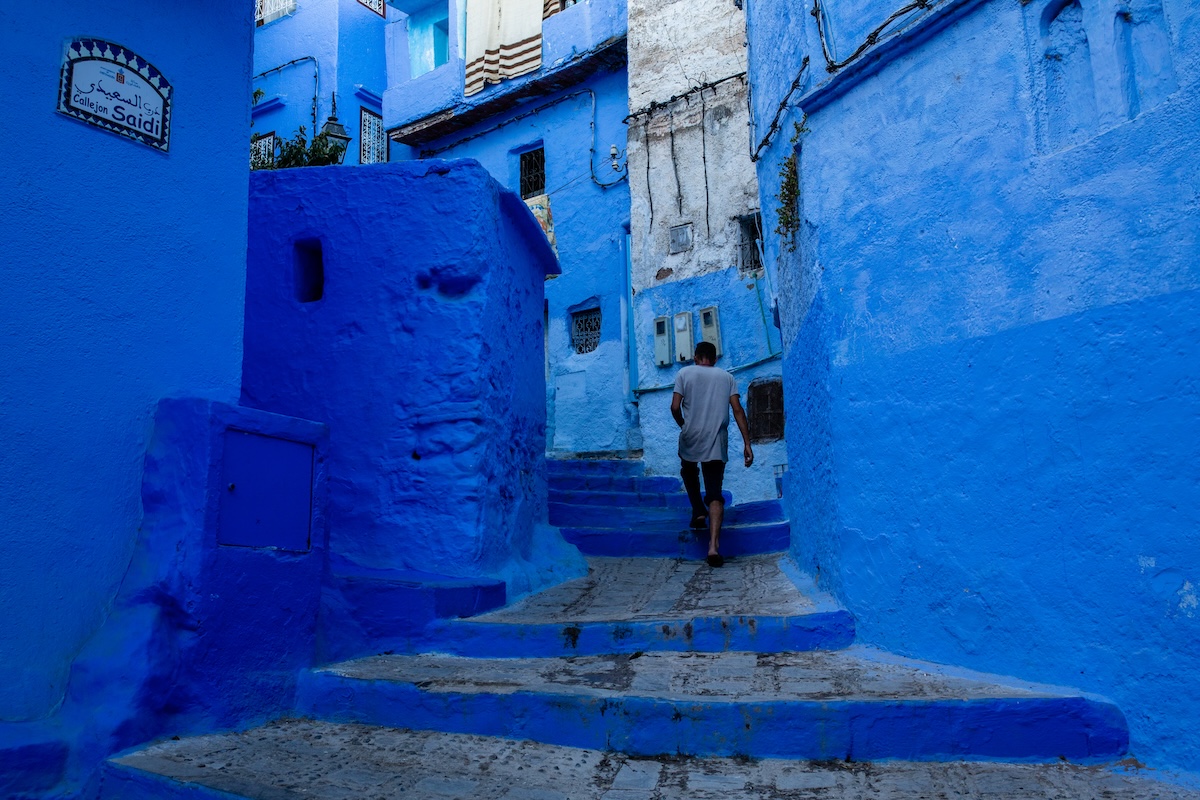
The Medina of Chefchaouen, known for its stunning blue-painted buildings, offers a tranquil escape in the Rif Mountains of Morocco. This charming town, founded in the 15th century, was originally a fortress, which has now evolved into a haven of serenity and artistic inspiration.
The blue walls, a tradition stemming from the town’s Jewish heritage, create a mesmerizing and photogenic landscape that attracts visitors from around the world.
Walking through the narrow, winding streets of Chefchaouen’s Medina is like navigating through a dreamlike, azure maze. The town’s relaxed atmosphere is complemented by its friendly locals and the small, quaint shops selling handicrafts and traditional goods. The Medina is of cultural significance, reflecting a blend of Moroccan and Andalusian influences.
The town’s architecture, cuisine, and handicrafts offer insights into the rich heritage and lifestyle of its inhabitants. Its location in the Rif Mountains provides opportunities for outdoor activities like hiking, making it a perfect destination for those seeking both cultural immersion and natural beauty.
Know Before You Go:
Best Time to Visit: Spring (April to June) for pleasant weather.
Getting There: Bus or taxi from major cities like Tangier or Fes.
Duration: A day or two to fully explore.
Tickets: Free access to the Medina.
Facilities: Restaurants, cafes, and guesthouses available.
Accessibility: Steep and uneven paths may be challenging for those with mobility issues.
Chellah Necropolis
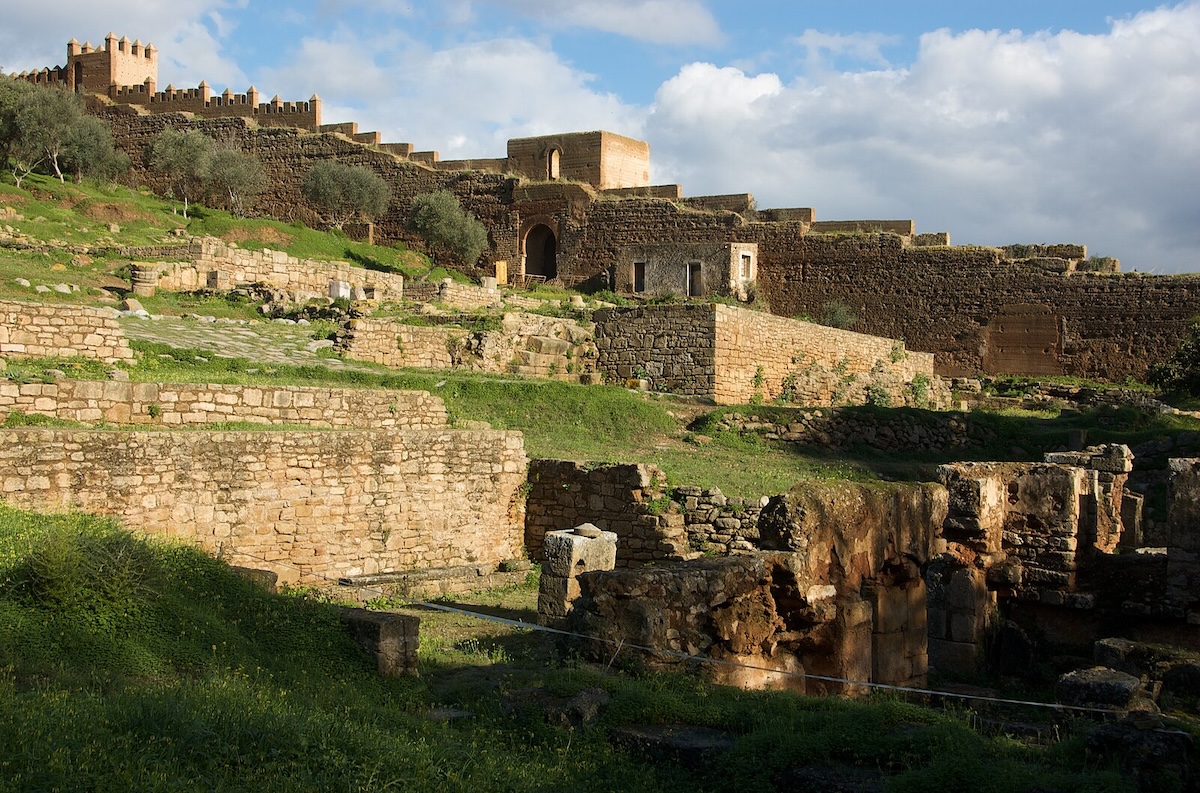
Chellah Necropolis, located in Morocco’s capital, Rabat, is a historic and peaceful site, blending the ruins of a Roman city with a later Islamic complex. Originally a Roman settlement, Chellah was transformed into a royal burial ground in the 14th century. The site offers a unique glimpse into the layers of Morocco’s history, showcasing remnants from the Roman, Islamic, and Merenid periods.
Exploring Chellah is like walking through time, with its Roman ruins, Islamic tombs, and the remains of the medieval mosque and minaret. The site is not only an important historical landmark but also a place of peace and natural beauty.
The lush gardens and the presence of storks add a sense of tranquillity to the historical ambience.
Chellah’s blend of history, nature, and tranquillity makes it a must-visit destination in Rabat. It offers a reflective journey through Morocco’s past and a peaceful escape from the hustle and bustle of city life. The site’s atmosphere is further enriched by cultural events, like the annual Jazz Festival, adding a contemporary touch to its historical backdrop.
Know Before You Go:
Best Time to Visit: Morning or late afternoon to avoid the heat.
Getting There: Short taxi ride from downtown Rabat.
Duration: 1 to 2 hours.
Tickets: Small entrance fee of 70 Moroccan Dirhams.
Facilities: Extremely limited; more options are available in the nearby city center.
Accessibility: Some areas are accessible, but the uneven terrain can be challenging.
Medina of Essaouira
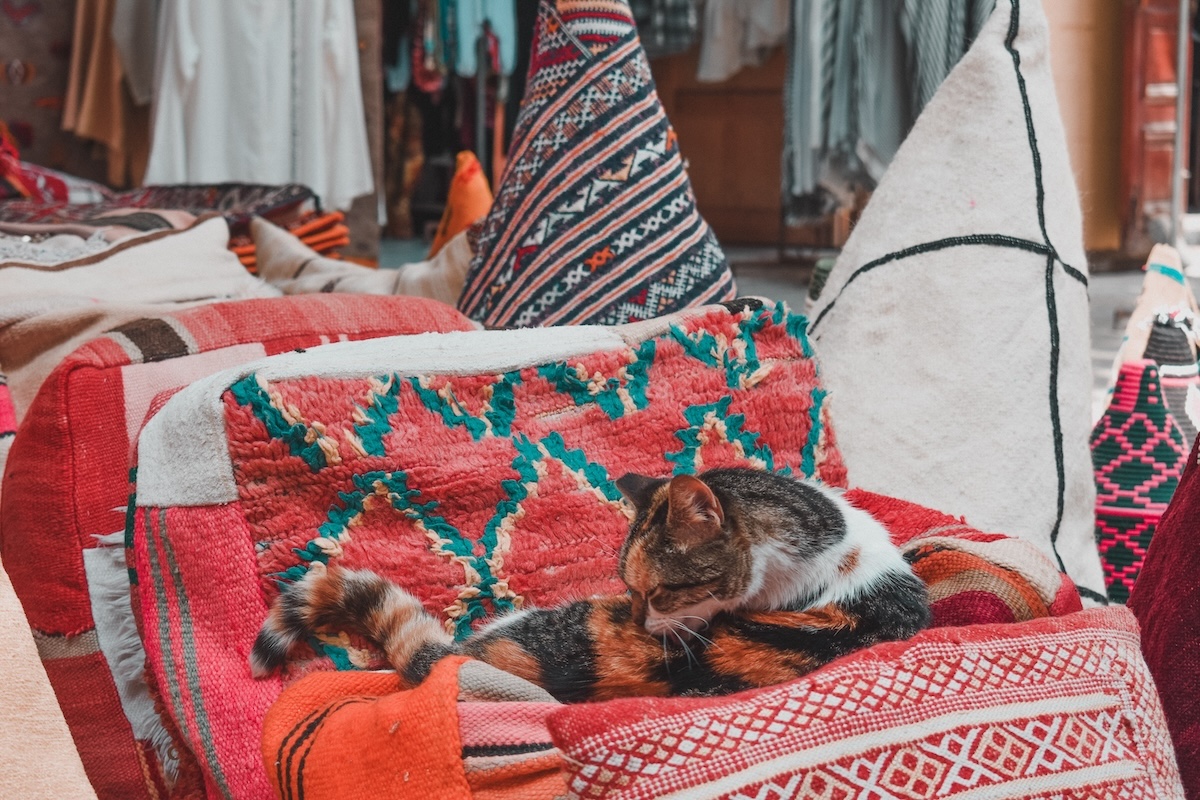
The Medina of Essaouira, a UNESCO World Heritage site, is a captivating blend of Portuguese, French, and Berber architecture. Its coastal location has historically made it a significant port city, and today, its fortified walls and bustling fishing harbor offer a glimpse into its rich past. The Medina is famous for its relaxed atmosphere, contrasting with the more hectic Medinas of larger Moroccan cities.
Strolling through Essaouira’s Medina, visitors are met with a labyrinth of narrow alleys, whitewashed houses with blue shutters, and vibrant marketplaces. Art galleries, wood workshops, and seafood restaurants add to the charm of this coastal town.
The Medina’s blend of cultural influences is evident in its architecture, cuisine, and artisanal crafts, making it a unique cultural destination.
Essaouira’s Medina offers a serene and artistic experience, perfect for travelers seeking a blend of history, culture, and relaxation. The sea breeze and the sound of seagulls complement the town’s laid-back vibe, making it an ideal destination for those looking to experience Morocco’s coastal culture.
Know Before You Go:
Best Time to Visit: Spring and Autumn for mild weather.
Getting There: Bus or private transport from Marrakech or Casablanca.
Duration: A day or two for a relaxed exploration.
Tickets: Free access to the Medina.
Facilities: Numerous cafes, restaurants, and accommodations.
Accessibility: Narrow and uneven streets may pose challenges for mobility.
Al Attarine Madrasa
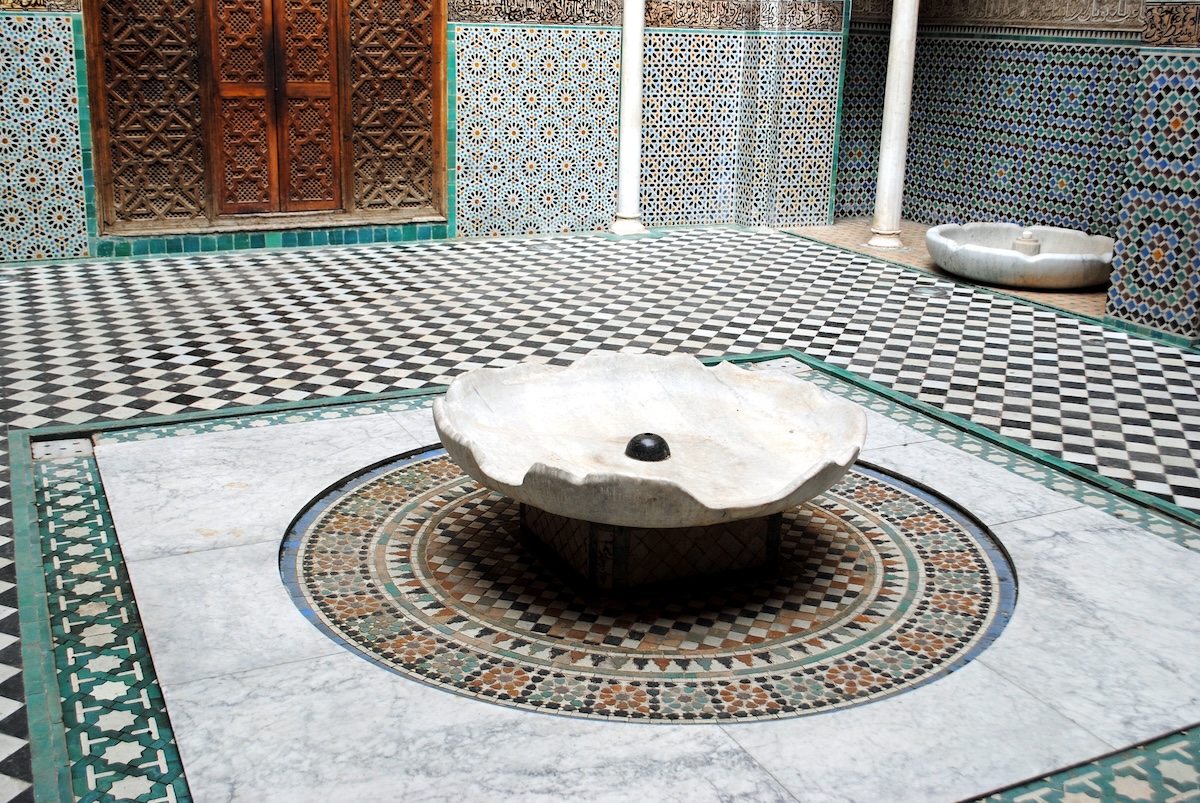
Al Attarine Madrasa, located near the famous Al-Qarawiyyin Mosque in Fez, is an exquisite example of Marinid architecture.
Built in the 14th century, it was once a center for learning and spirituality. The Madrasa is renowned for its intricate Islamic art, including carved wood, stucco, and zellige tilework, which reflect the artistic ingenuity of the period.
The Madrasa’s interior is a testament to the sophistication of Islamic educational institutions of the era. Its courtyard, adorned with elaborate geometric patterns and Arabic inscriptions, offers a peaceful retreat. Each element of the Madrasa, from the prayer hall to the student dormitories, is designed with meticulous attention to detail, making it a masterpiece of Moroccan heritage.
Visitors to Al Attarine Madrasa are often struck by the tranquillity and beauty of the space. It’s not just an architectural site but a journey into the rich academic and spiritual history of Morocco. The Madrasa stands as a symbol of Fez’s status as a medieval center of learning and culture.
Know Before You Go:
Best Time to Visit: Morning to avoid crowds.
Getting There: Within walking distance from the center of Fez’s Medina.
Duration: 1 hour.
Tickets: Free!
Facilities: Limited on-site; more options in the Medina.
Accessibility: Some areas may be challenging for those with mobility issues.
Blue Gate
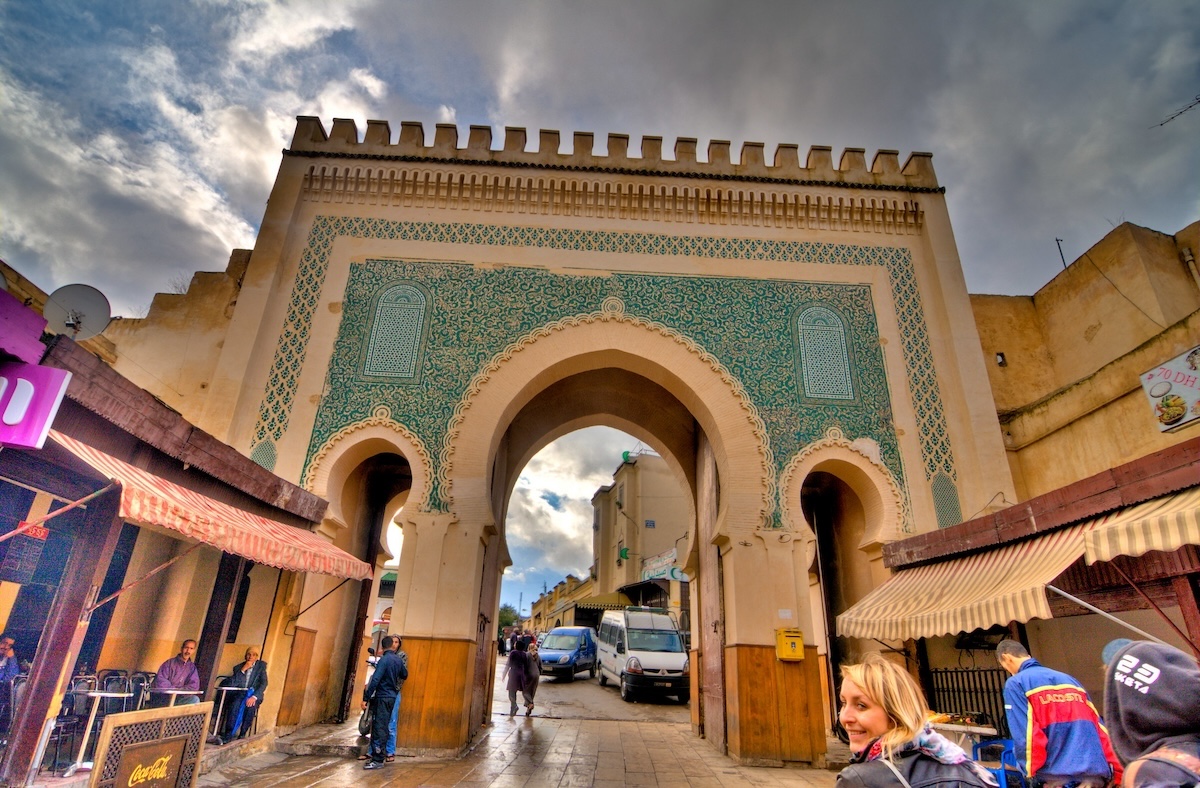
The Blue Gate (Bab Bou Jeloud) in Fez is more than just an entryway; it’s a symbol of the city’s rich history and cultural vibrancy. This iconic gate, with its striking blue and green tiles, marks the entrance to Fez’s famous Medina. Built in the early 20th century, the gate is a relatively modern addition, yet it seamlessly blends with the ancient charm of the city.
Walking through the Blue Gate is like stepping into a different era. The bustling streets of the Medina, with its myriad of shops, cafes, and historical sites, unfold before you. The gate serves as a transition point from the new Fez to the old, encapsulating the city’s blend of tradition and modernity.
Visitors often use the Blue Gate as a starting point for their exploration of Fez. Its beauty and location make it a popular spot for photos and a memorable landmark for anyone visiting the city. The area around the gate buzzes with activity, offering a glimpse into the daily life and culture of Fez.
Know Before You Go:
Best Time to Visit: Daytime for the best views and vibrant atmosphere.
Getting There: Accessible by taxi or a short walk from other parts of the city.
Duration: Typically a brief visit as part of a larger tour of the Medina.
Tickets: No entrance fee and you’re already there if you consider our above tip!
Facilities: Numerous shops and cafes in the vicinity.
Accessibility: Busy area, generally navigable but can be crowded.
Djemaa el-Fna Square
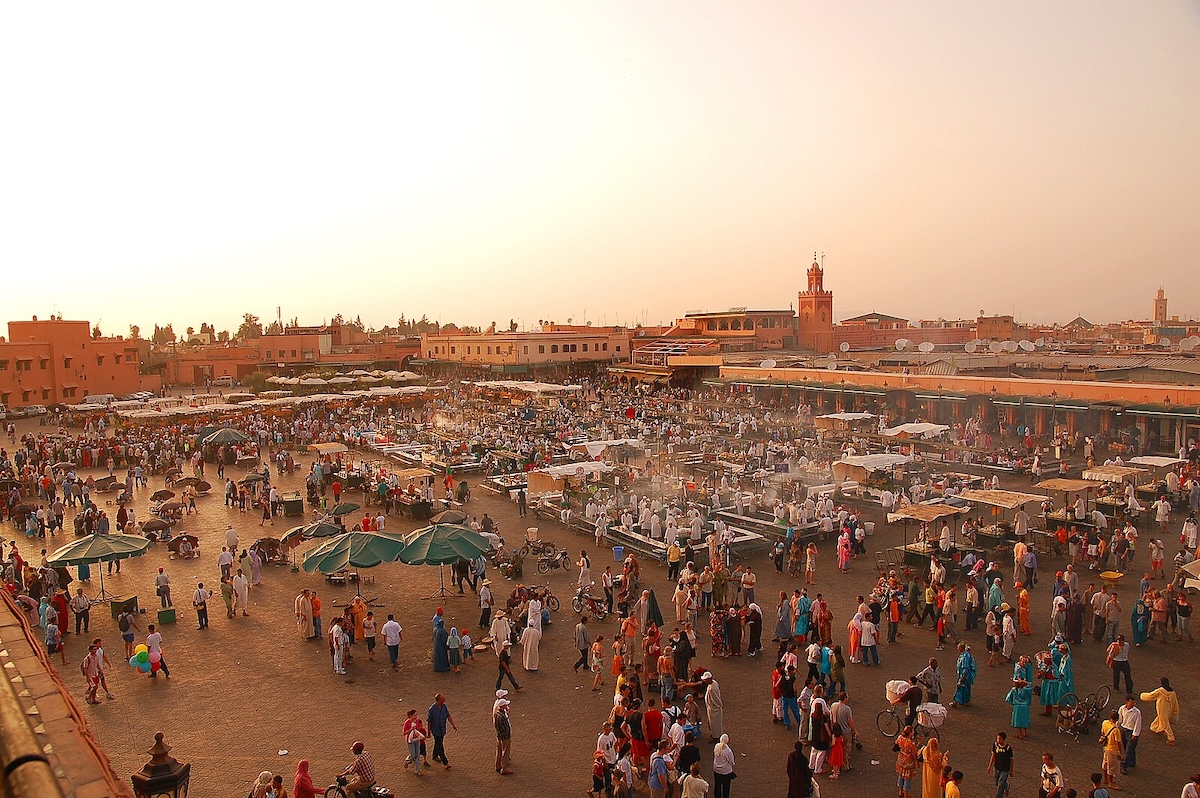
Djemaa el-Fna Square, the pulsating heart of Marrakech, is a spectacle of sights, sounds, and aromas. By day, this UNESCO Masterpiece of the Oral and Intangible Heritage of Humanity buzzes with snake charmers, street performers, and stalls selling traditional goods. As night falls, it transforms into a massive open-air dining area, with food stalls serving an array of Moroccan delicacies.
The square is more than a tourist attraction; it’s a living representation of Moroccan culture and daily life. The energy is palpable, as locals and tourists alike gather to experience the vibrancy of Marrakech. The square serves as a cultural melting pot, where traditional Moroccan life meets the dynamism of the modern world.
Visiting Djemaa el-Fna Square offers an immersive experience of Moroccan culture. The sights, from the traditional dancers to the storytellers, and the tastes, from the fresh orange juice to the aromatic tagines, make it a sensory feast. This square is not just a place but an experience, capturing the essence of Marrakech’s spirit.
Know Before You Go:
Best Time to Visit: Evening for the full culinary and cultural experience.
Getting There: Accessible on foot from nearby areas in Marrakech or by taxi.
Duration: Several hours to fully enjoy the atmosphere.
Tickets: Free to enter; various costs for food and entertainment.
Facilities: Plenty of food options; limited public restrooms.
Accessibility: Generally accessible but can be very crowded.
Jardin Majorelle
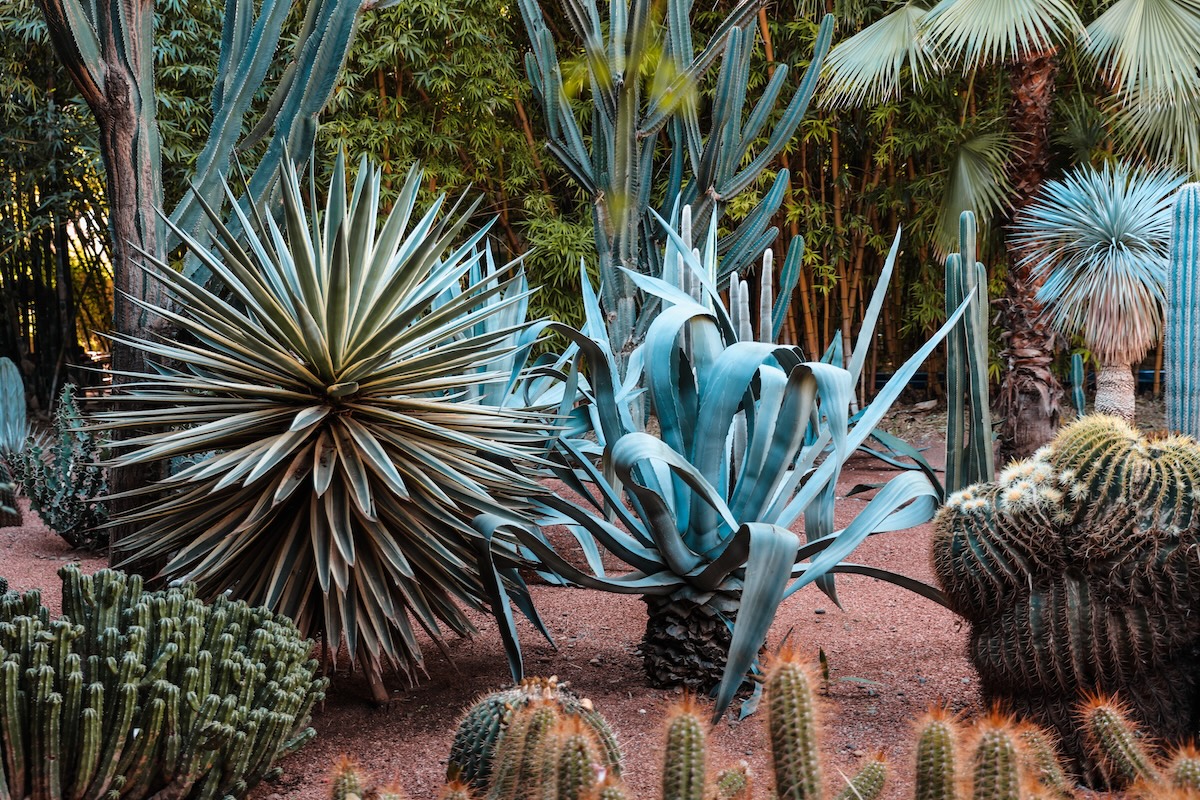
Jardin Majorelle, a botanical garden in Marrakech, is an oasis of calm and vibrant colors, created by French painter Jacques Majorelle in the 1920s. Famous for its striking cobalt blue accents, the garden is a delightful blend of exotic plants and Art Deco influences. Over the years, it became closely associated with fashion designer Yves Saint Laurent, who restored the garden after it fell into disrepair.
The garden’s paths lead visitors through a tranquil and lush landscape, with a diverse collection of plants from across the globe. The vibrant colors of the garden, particularly Majorelle Blue, create a striking backdrop against the greenery. This place is not just about flora; it’s also home to the Islamic Art Museum of Marrakech, showcasing North African textiles, ceramics, and art.
Jardin Majorelle is more than a garden; it’s a source of inspiration and a retreat from the bustling city. The harmony of colors, the soothing sound of running water, and the shade of tall palms provide a peaceful and rejuvenating experience. It’s a testament to the fusion of natural beauty and human creativity.
Know Before You Go:
Best Time to Visit: Morning to avoid crowds and enjoy cooler temperatures.
Getting There: Taxi or a long walk from the Medina.
Duration: 1 to 2 hours.
Tickets: An entrance fee of 70 Moroccan Dirhams is required; a separate ticket for the museum costs 30 Moroccan Dirhams.
Facilities: Cafe and bookshop on site.
Accessibility: Mostly accessible with some paved pathways.
Natural Landmarks in Morocco
Morocco’s natural landmarks offer a captivating journey through diverse and stunning landscapes. From the well-known majestic Atlas Mountains, home to Berber villages to the needing-no-introductions Sahara Desert, let’s dive into Morocco’s most popular and understated natural country icons.
Atlas Mountains
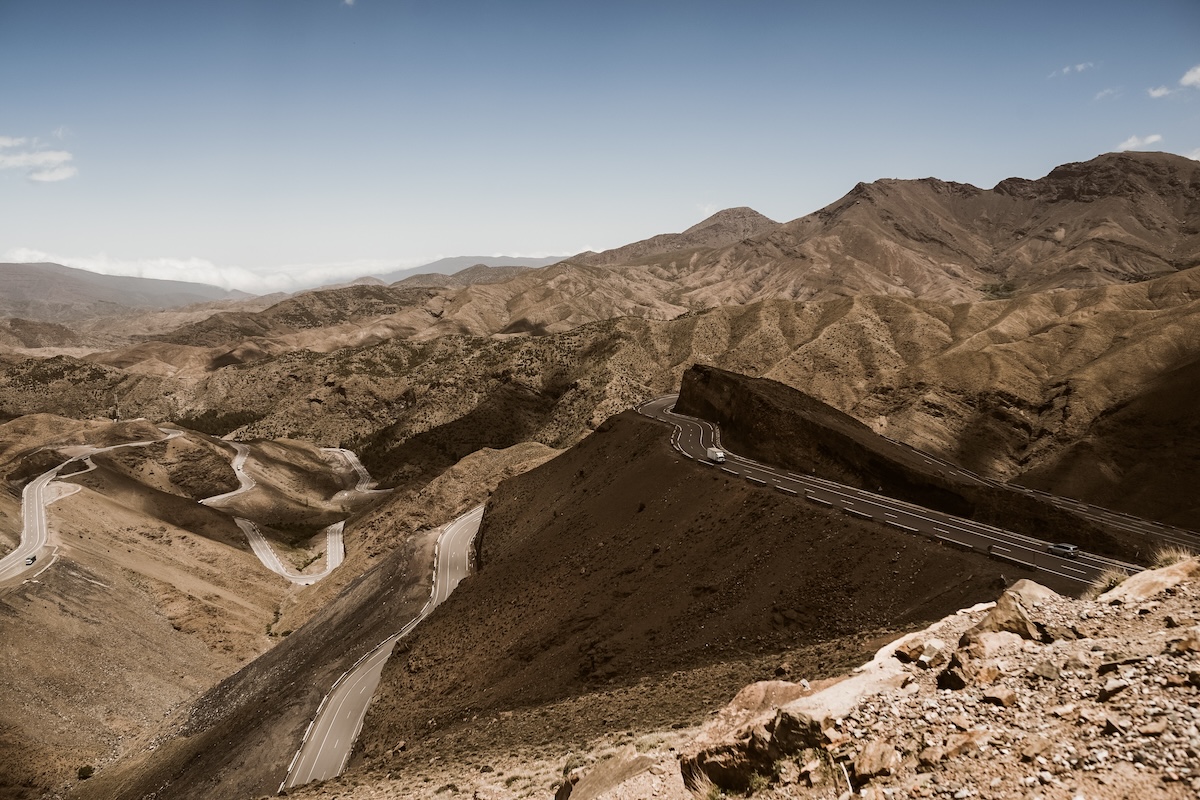
The Atlas Mountains, stretching across Morocco, are a haven for nature lovers and adventurers. This mountain range, with its diverse landscapes, offers views worth a wolf-whistle or two, trekking opportunities, and a glimpse into the traditional Berber culture.
The mountains are not just a natural wonder but also an immersive cultural experience, with Berber villages dotting the landscape and providing insights into a way of life that has endured for centuries.
Visitors to the Atlas Mountains can explore lush valleys, snow-capped peaks, and peaceful Berber villages. The region is perfect for hiking, mountain biking, and winter skiing, catering to a wide range of interests and skill levels. The natural beauty of the area is complemented by the warmth and hospitality of the Berber people, making it a memorable destination.
The Atlas Mountains offer a contrast to the bustling cities of Morocco, providing a serene and natural escape. The region’s diverse ecosystems, from cedar forests to rocky peaks, make every journey a discovery. It’s a place where adventure meets tradition, offering something for every traveler.
Know Before You Go:
Best Time to Visit: Spring (April-June) for pleasant hiking conditions.
Getting There: Accessible by car or bus from major cities like Marrakech.
Duration: Day trips to multi-day treks.
Tickets: Free access; fees for guides or treks vary.
Facilities: Limited in remote areas; more available in nearby villages.
Accessibility: Varies; some trails may be challenging for those with mobility issues.
Sahara Desert
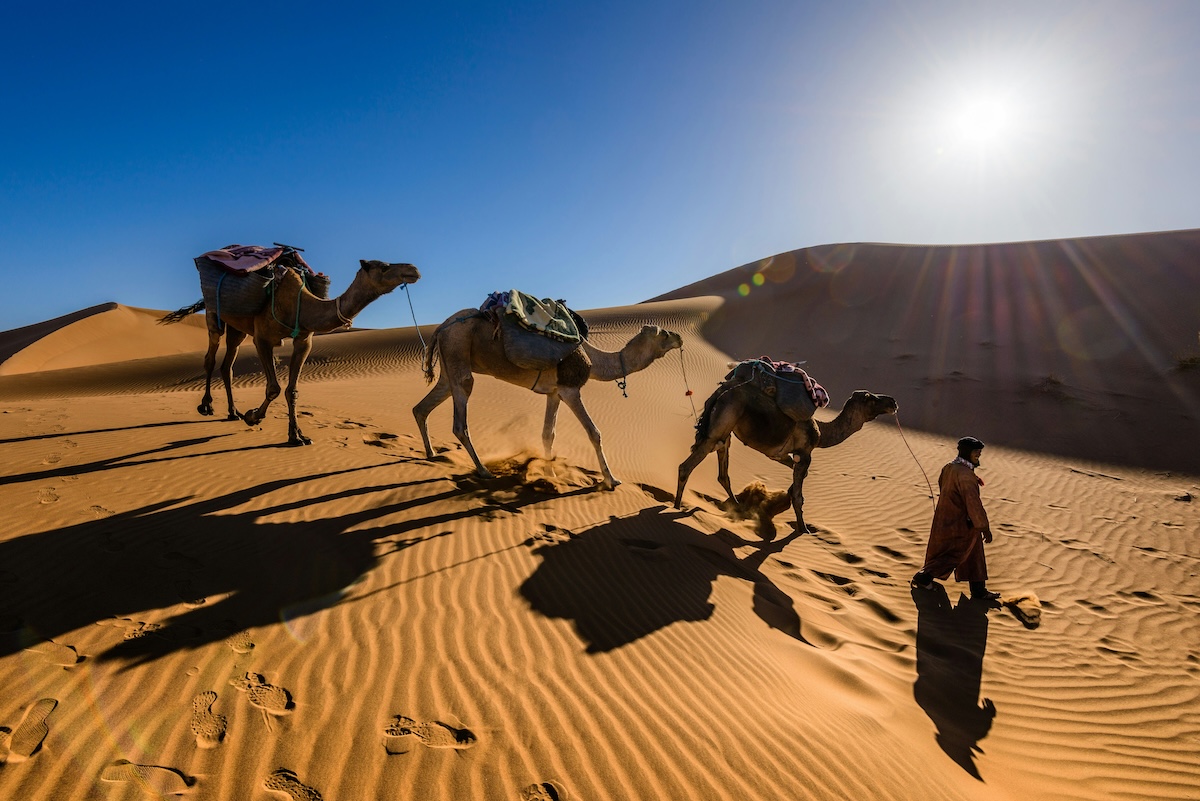
The Sahara Desert in Morocco is an iconic landscape of vast, rolling dunes, offering an unforgettable experience of the world’s largest hot desert. A visit to the Sahara is a journey into an environment of extreme beauty and tranquillity. The desert’s ever-changing dunes and clear starry nights make it a magical destination.
Exploring the Sahara can include camel treks, camping under the stars, and witnessing breathtaking sunrises and sunsets. The desert’s greatness and the silence of its expanses offer a unique sense of solitude and introspection. Visitors often find a trip to the Sahara to be a profound and life-changing experience.
The Sahara Desert is not just about the landscape; it’s also about the cultural experiences. Meeting local nomads and learning about their way of life adds depth to the journey. The desert’s challenging environment and the resilience of its inhabitants offer a new perspective on life.
Know Before You Go:
Best Time to Visit: October to April for milder temperatures.
Getting There: Accessible via guided tours from Marrakech, Fes, or Merzouga.
Duration: Typically 2-3 days for a desert tour, including overnight camping.
Tickets: Varies based on tour operator and package.
Facilities: Basic facilities in desert camps; more amenities in nearby towns.
Accessibility: Challenging for those with mobility issues due to sandy terrain.
Dades Valley
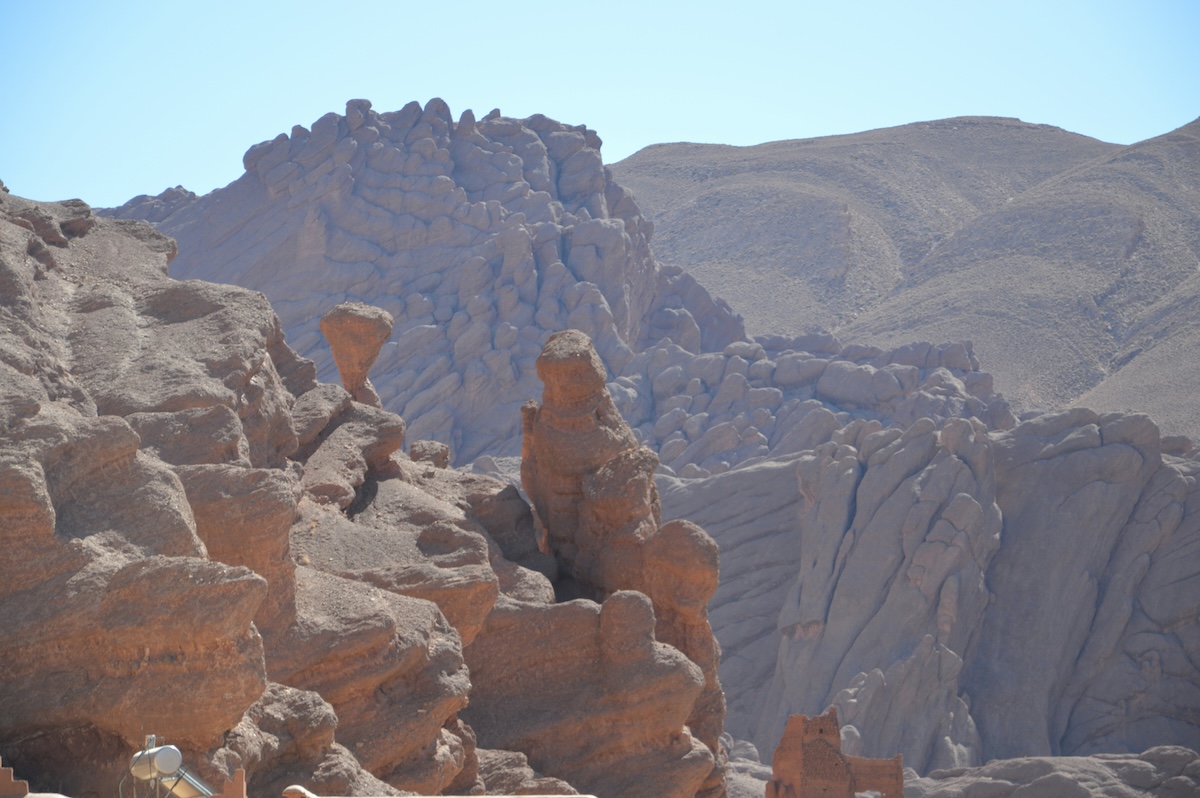
The Dades Valley, celebrated for its breathtaking landscapes and the renowned Valley of Roses, is a highlight in the High Atlas region of Morocco. Famous for its flourishing rose gardens and unique geological formations like the Monkey Fingers, the valley offers scenic drives and captivating views along the Road of a Thousand Kasbahs.
It’s a place where visitors can immerse themselves in the natural beauty and explore the rich Berber culture.
The valley’s charm is not just in its gorgeousness but also in its cultural richness. Visitors are often welcomed with the traditional Berber hospitality, providing an authentic insight into the local way of life. The annual Rose Festival is a particular highlight, celebrating the region’s rose harvest.
Dades Valley’s combination of natural grandeur and cultural authenticity makes it a must-visit destination. It offers visitors a chance to connect with nature and experience the traditional Moroccan culture, making it an ideal spot for both nature lovers and cultural enthusiasts.
Know Before You Go:
Best Time to Visit: Spring for the Rose Festival, though it’s beautiful year-round.
Getting There: Accessible by car or guided tours from Ouarzazate or Marrakech.
Duration: Ideal for a day trip, but longer stays are rewarding for hiking and exploration.
Tickets: No entrance fee; guided tour costs vary.
Facilities: Local guesthouses and restaurants are available.
Accessibility: Some areas may have limited access, but main viewpoints are generally accessible.
Ouzoud Waterfalls
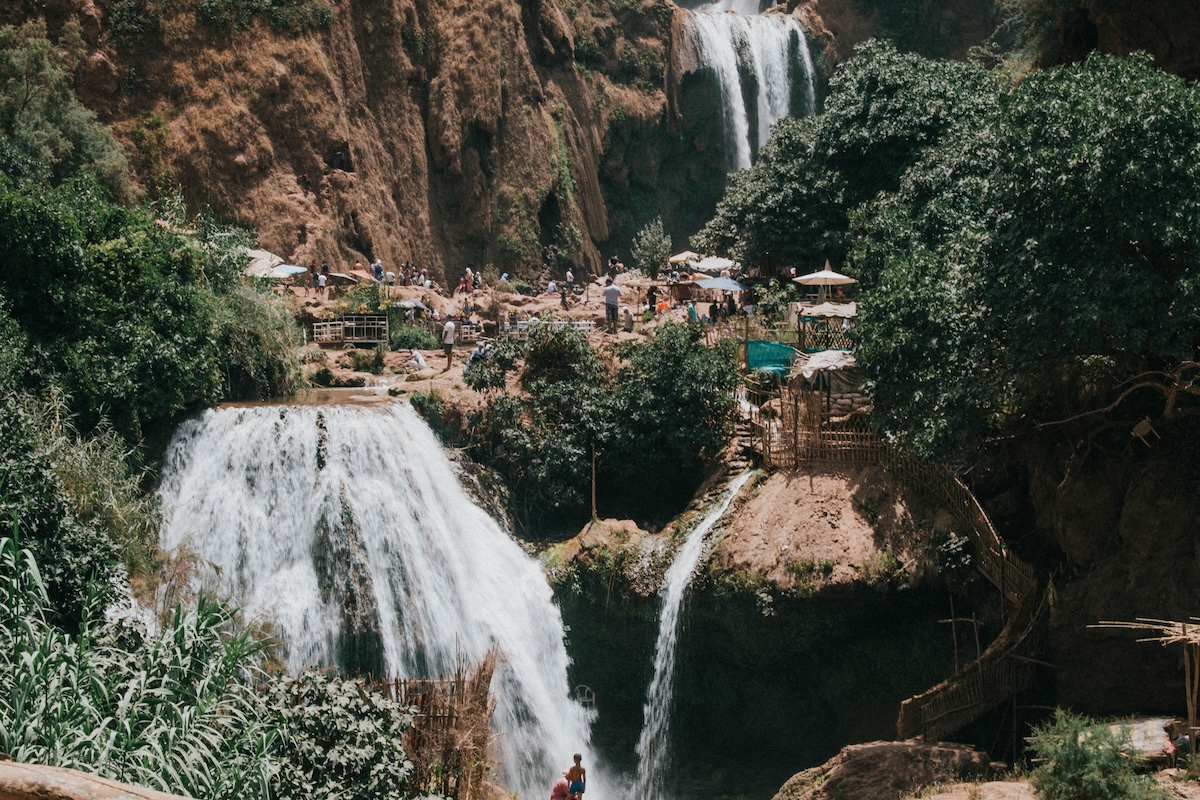
Ouzoud Waterfalls, located in the Grand Atlas village of Tanaghmeilt, is a magnificent natural spectacle in Morocco. As one of the most stunning and tallest waterfalls in the country, they offer a refreshing and picturesque retreat.
The area around the waterfalls is a lush haven, home to diverse flora and fauna, including friendly (until they’re not) Barbary macaques.
Visitors can indulge in various activities like hiking down to the base of the falls, taking a refreshing swim, or enjoying a leisurely boat ride for a closer view of the cascading water. The surrounding natural landscape provides an ideal backdrop for picnics and relaxation.
Ouzoud Waterfalls is not just about natural beauty; it’s also about experiencing the tranquillity and the rejuvenating power of nature. The sound of the falls, the cool mist, and the serene environment make it a perfect escape for those seeking a break from the hustle and bustle of city life.
Know Before You Go:
Best Time to Visit: Spring for verdant surroundings; summer for a cool escape.
Getting There: A drive or a guided tour from Marrakech.
Duration: Ideal for a half-day to full-day excursion.
Tickets: Free to view; small fees for boat rides and local guides.
Facilities: Restaurants and cafes are available in the vicinity.
Accessibility: The path to the base of the falls may be challenging for those with mobility issues.
Legzira Beach
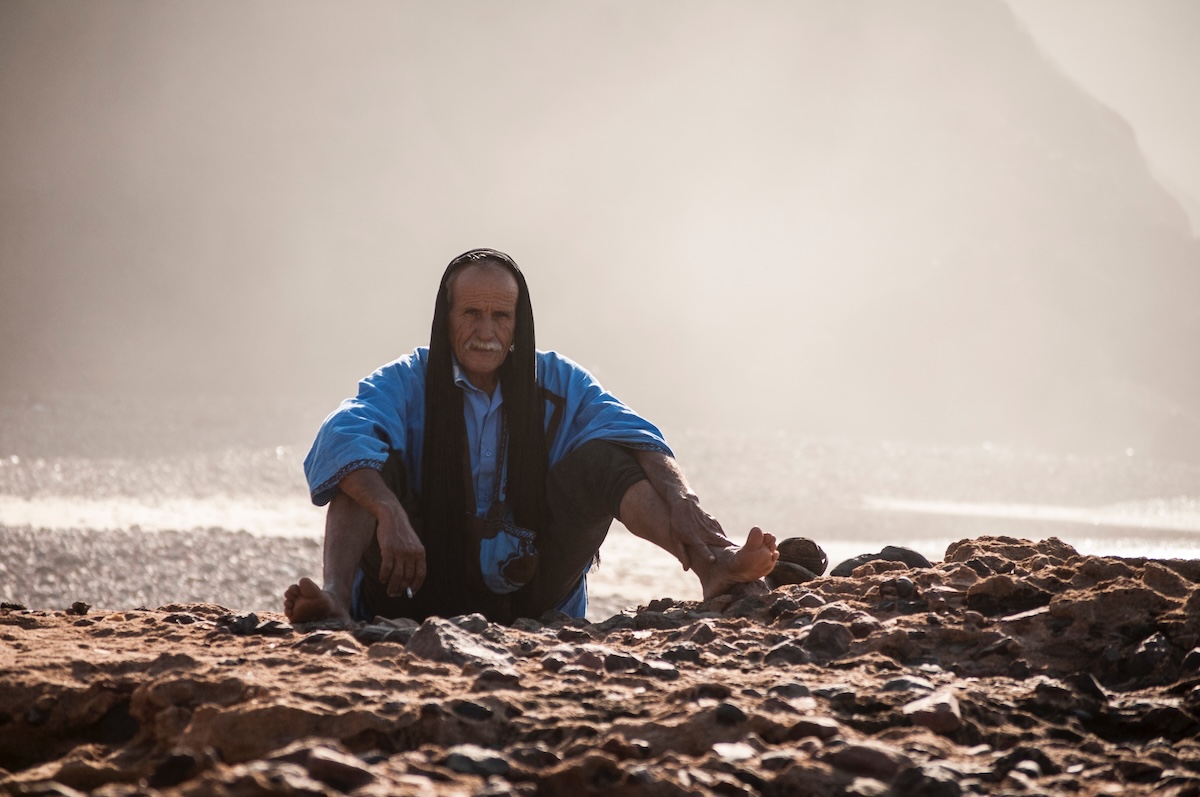
Legzira Beach, located on Morocco’s Atlantic coast, is renowned for its natural beauty and distinctive red arches carved into the cliffside by the ocean. This beach is a natural landmark in Morocco, offering stunning sunsets and a tranquil atmosphere.
The dramatic landscape of Legzira, with its massive rock formations and the soothing sound of waves, makes it a perfect retreat for nature lovers and photographers.
Visiting Legzira Beach is a unique experience, different from typical beach destinations. The beach’s secluded location offers a sense of solitude and serenity. Walking along the shore, especially during low tide when the arches are fully visible, is an unforgettable experience. The beach’s reddish hue, combined with the Atlantic’s blue, creates a mesmerizing contrast.
Know Before You Go:
Best Time to Visit: Late afternoon for the best sunsets.
Getting There: Drive from nearby towns like Sidi Ifni.
Duration: A few hours to a full day.
Tickets: Free access.
Facilities: Limited; some cafes and restaurants in the area.
Accessibility: Beach access may be challenging for those with mobility issues.
Todra Gorge
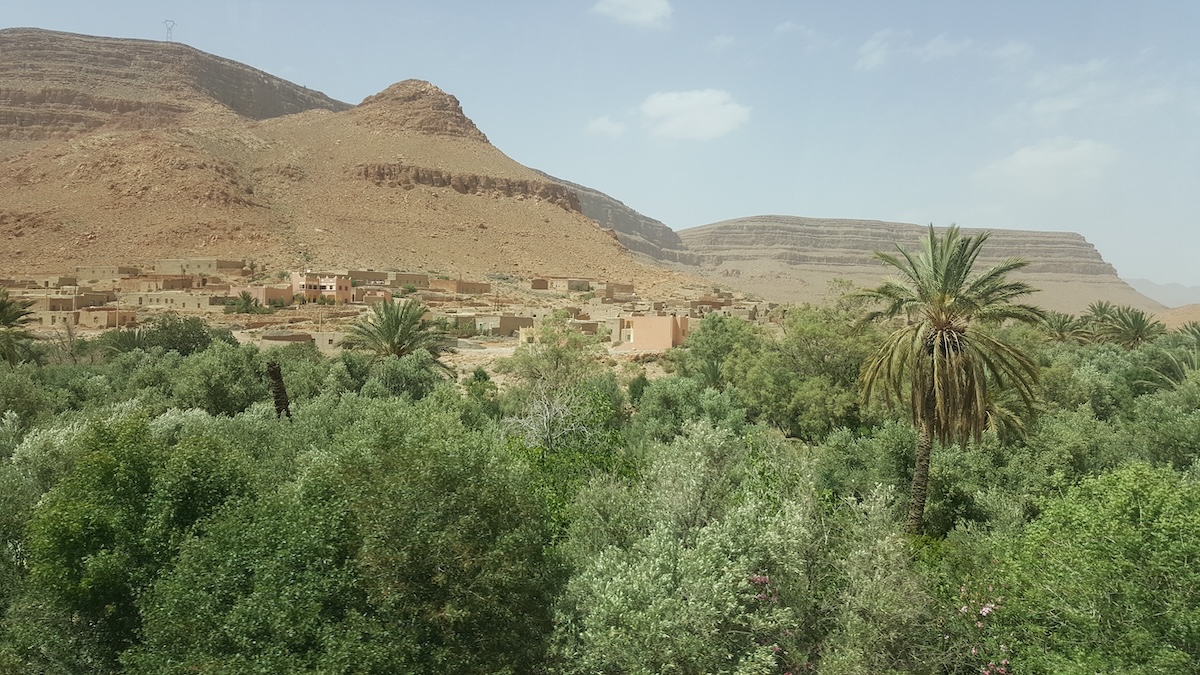
Todra Gorge, situated in the eastern part of the High Atlas Mountains, is a spectacular natural wonder known for its towering vertical limestone cliffs. The gorge, carved out by the Todra River over centuries, offers an awe-inspiring landscape that attracts hikers, climbers, and nature enthusiasts. The dramatic scenery of Todra Gorge, with its narrowest point being just 10 meters wide, provides a unique outdoor adventure.
The gorge is not only a destination for adventure seekers but also a place of natural beauty and tranquillity. The sound of the river flowing through the canyon, the sight of local wildlife, and the towering cliffs create a serene and inspiring environment.
Tourists can explore the walking paths, enjoy the local Berber culture, and discover the hidden beauty of this natural wonder.
Todra Gorge offers an escape into the heart of nature, where the majesty of the Atlas Mountains is on full display. It’s a place where you can experience the grandeur of the landscape and the rich cultural heritage of the region.
Know Before You Go:
Best Time to Visit: Spring and Autumn for pleasant weather.
Getting There: Drive or take a guided tour from Tinghir.
Duration: A few hours to a full day, depending on activities.
Tickets: Free access.
Facilities: Local guesthouses and restaurants nearby.
Accessibility: Some areas are accessible, but the rugged terrain may be challenging for those with mobility issues.
Rif Mountains
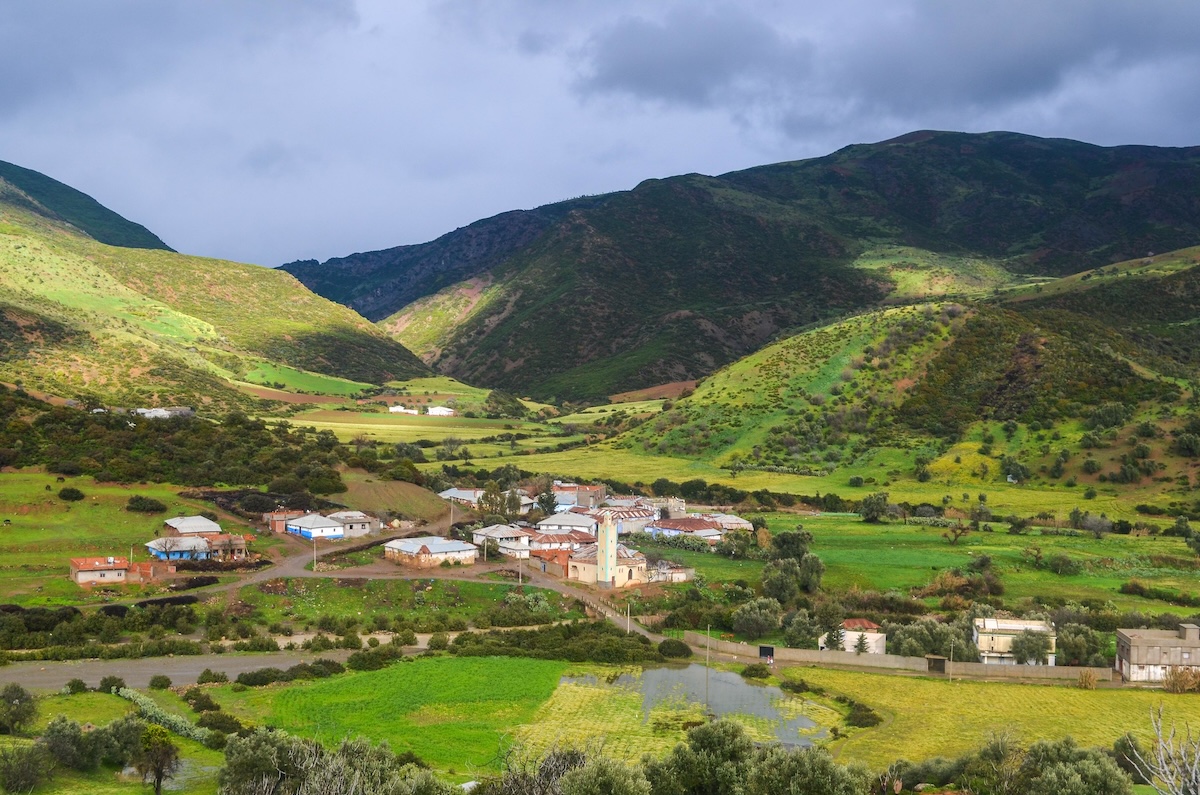
The Rif Mountains in northern Morocco present a landscape of natural splendor and cultural richness. Unlike the more frequented Atlas Mountains, the Rif offers a sense of seclusion and unspoiled nature.
The region is characterized by its lush, green valleys and rugged peaks, making it a paradise for hikers and nature enthusiasts. The Rif Mountains are a natural wonder which is also home to the indigenous Amazigh (Berber) people, whose unique culture and traditions add to the region’s charm.
Exploring the Rif Mountains reveals a different side of Morocco.
The region is significantly less touristic, offering a more authentic experience of Moroccan rural life. The small villages nestled in the mountains are picturesque, with traditional houses and a slower pace of life. This area is particularly known for its cannabis plantations, which, while controversial, are an integral part of the local economy and culture.
Visiting the Rif Mountains is an opportunity to immerse oneself in the tranquillity of nature and the richness of Amazigh culture.
From the scenic town of Chefchaouen, known for its blue-painted buildings, to the more remote and less explored trails, the Rif Mountains provide a retreat for those seeking solitude and cultural experiences.
Know Before You Go:
Best Time to Visit: Spring (April to June) for pleasant weather and blooming landscapes.
Getting There: Accessible by car or local transport from cities like Chefchaouen or Tetouan.
Duration: Ideal for day trips or longer for immersive hiking experiences.
Tickets: Free access to most areas; some specific attractions may have fees.
Facilities: Limited in remote areas; more available in towns like Chefchaouen.
Accessibility: Varied; some areas may be challenging for those with mobility issues due to rugged terrain.
Merzouga (Erg Chebbi)
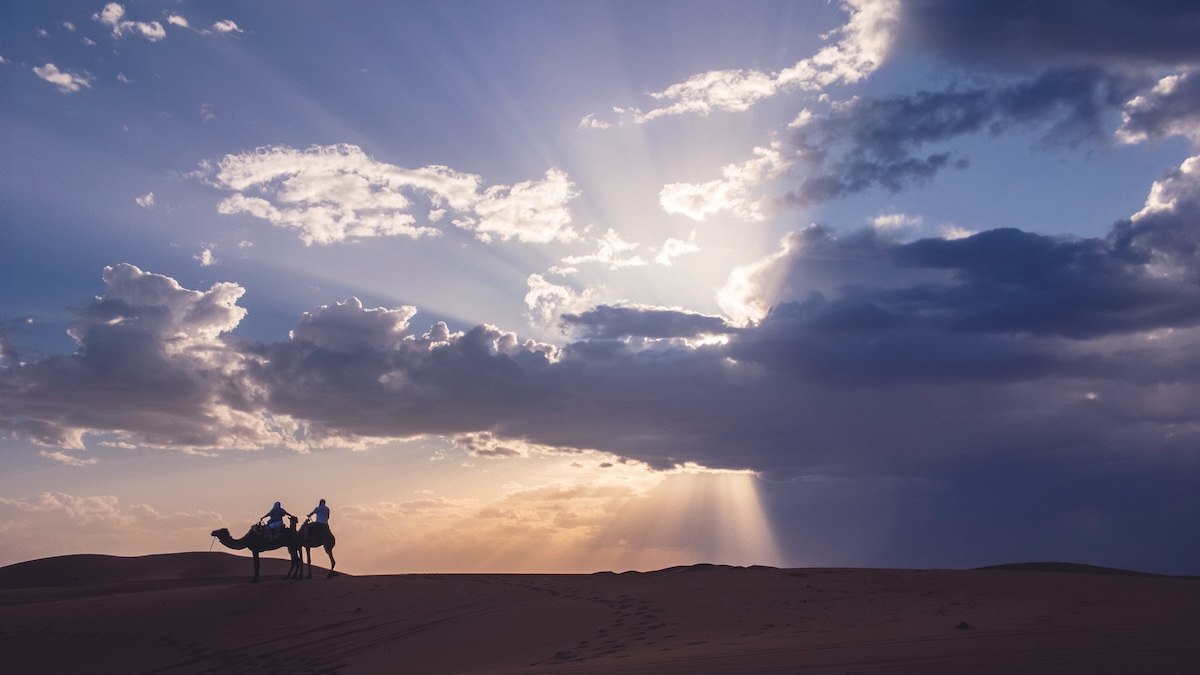
Merzouga, a small village in southeastern Morocco, is the gateway to the stunning Erg Chebbi dunes, part of the Sahara Desert.
This area is renowned for its huge dunes that create an otherworldly landscape. The experience of watching the dunes change color from golden to reddish-pink as the sun sets or rises is mesmerizing and a highlight for many travelers.
Merzouga offers a quintessential desert experience, including camel treks, overnight stays in desert camps, and star-gazing in the clear night sky.
The allure of Merzouga extends beyond its natural beauty. It’s an opportunity to experience the local Berber culture. Visitors can interact with local communities, learn about their traditions, and even enjoy Berber music around a campfire. The hospitality and warmth of the locals enhance the desert experience, providing a deeper understanding of life in this harsh, yet beautiful environment.
Know Before You Go:
Best Time to Visit: Spring (March to May) and Autumn (September to November) for milder temperatures.
Getting There: Accessible by bus or car from cities like Marrakech or Fez.
Duration: Overnight stays are recommended for a full desert experience.
Tickets: Varies for camel treks and desert camps.
Facilities: Basic facilities in desert camps; more amenities in Merzouga village.
Accessibility: The desert environment can be challenging, particularly for those with mobility issues.
So there you go, fellow travelers; we have stated our case to the jury. There are so many famous landmarks in Morocco both made by man and nature, that are worth your time if you are ever brave enough to experience this country beyond the pushy touristy markets of Marakesh.

